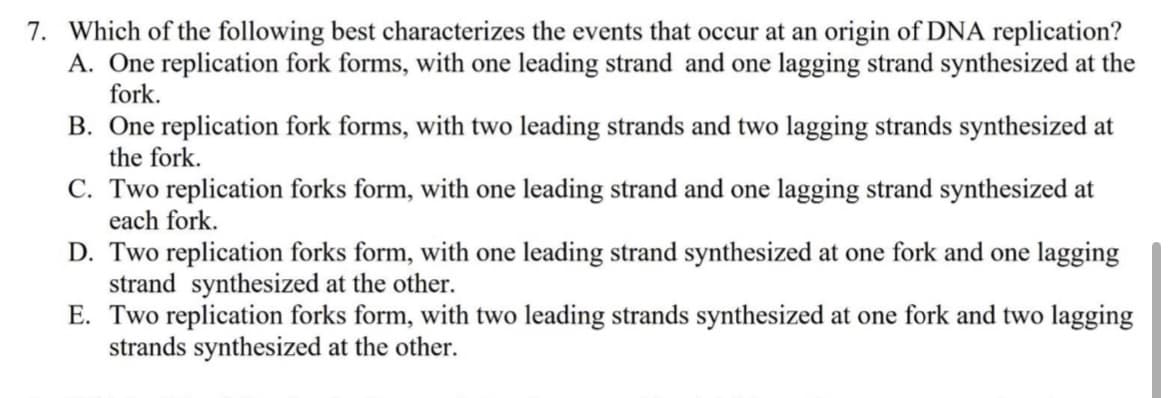7. Which of the following best characterizes the events that occur at an origin of DNA replication? A. One replication fork forms, with one leading strand and one lagging strand synthesized at the fork. B. One replication fork forms, with two leading strands and two lagging strands synthesized at the fork. C. Two replication forks form, with one leading strand and one lagging strand synthesized at each fork. D. Two replication forks form, with one leading strand synthesized at one fork and one lagging strand synthesized at the other. E. Two replication forks form, with two leading strands synthesized at one fork and two lagging strands synthesized at the other.
7. Which of the following best characterizes the events that occur at an origin of DNA replication? A. One replication fork forms, with one leading strand and one lagging strand synthesized at the fork. B. One replication fork forms, with two leading strands and two lagging strands synthesized at the fork. C. Two replication forks form, with one leading strand and one lagging strand synthesized at each fork. D. Two replication forks form, with one leading strand synthesized at one fork and one lagging strand synthesized at the other. E. Two replication forks form, with two leading strands synthesized at one fork and two lagging strands synthesized at the other.
Biology (MindTap Course List)
11th Edition
ISBN:9781337392938
Author:Eldra Solomon, Charles Martin, Diana W. Martin, Linda R. Berg
Publisher:Eldra Solomon, Charles Martin, Diana W. Martin, Linda R. Berg
Chapter12: Dna: The Carrier Of Genetic Information
Section: Chapter Questions
Problem 8TYU: The statement DNA replicates by a semiconservative mechanism means that (a) only one DNA strand is...
Related questions
Question

Transcribed Image Text:7. Which of the following best characterizes the events that occur at an origin of DNA replication?
A. One replication fork forms, with one leading strand and one lagging strand synthesized at the
fork.
B. One replication fork forms, with two leading strands and two lagging strands synthesized at
the fork.
C. Two replication forks form, with one leading strand and one lagging strand synthesized at
each fork.
D. Two replication forks form, with one leading strand synthesized at one fork and one lagging
strand synthesized at the other.
E. Two replication forks form, with two leading strands synthesized at one fork and two lagging
strands synthesized at the other.
Expert Solution
This question has been solved!
Explore an expertly crafted, step-by-step solution for a thorough understanding of key concepts.
This is a popular solution!
Trending now
This is a popular solution!
Step by step
Solved in 3 steps with 1 images

Recommended textbooks for you

Biology (MindTap Course List)
Biology
ISBN:
9781337392938
Author:
Eldra Solomon, Charles Martin, Diana W. Martin, Linda R. Berg
Publisher:
Cengage Learning

Biology: The Dynamic Science (MindTap Course List)
Biology
ISBN:
9781305389892
Author:
Peter J. Russell, Paul E. Hertz, Beverly McMillan
Publisher:
Cengage Learning

Anatomy & Physiology
Biology
ISBN:
9781938168130
Author:
Kelly A. Young, James A. Wise, Peter DeSaix, Dean H. Kruse, Brandon Poe, Eddie Johnson, Jody E. Johnson, Oksana Korol, J. Gordon Betts, Mark Womble
Publisher:
OpenStax College

Biology (MindTap Course List)
Biology
ISBN:
9781337392938
Author:
Eldra Solomon, Charles Martin, Diana W. Martin, Linda R. Berg
Publisher:
Cengage Learning

Biology: The Dynamic Science (MindTap Course List)
Biology
ISBN:
9781305389892
Author:
Peter J. Russell, Paul E. Hertz, Beverly McMillan
Publisher:
Cengage Learning

Anatomy & Physiology
Biology
ISBN:
9781938168130
Author:
Kelly A. Young, James A. Wise, Peter DeSaix, Dean H. Kruse, Brandon Poe, Eddie Johnson, Jody E. Johnson, Oksana Korol, J. Gordon Betts, Mark Womble
Publisher:
OpenStax College

Biology: The Unity and Diversity of Life (MindTap…
Biology
ISBN:
9781337408332
Author:
Cecie Starr, Ralph Taggart, Christine Evers, Lisa Starr
Publisher:
Cengage Learning

Biology: The Unity and Diversity of Life (MindTap…
Biology
ISBN:
9781305073951
Author:
Cecie Starr, Ralph Taggart, Christine Evers, Lisa Starr
Publisher:
Cengage Learning